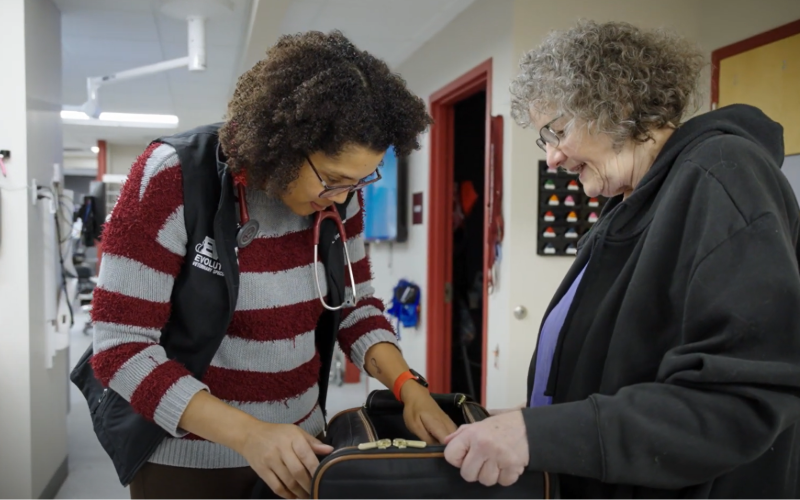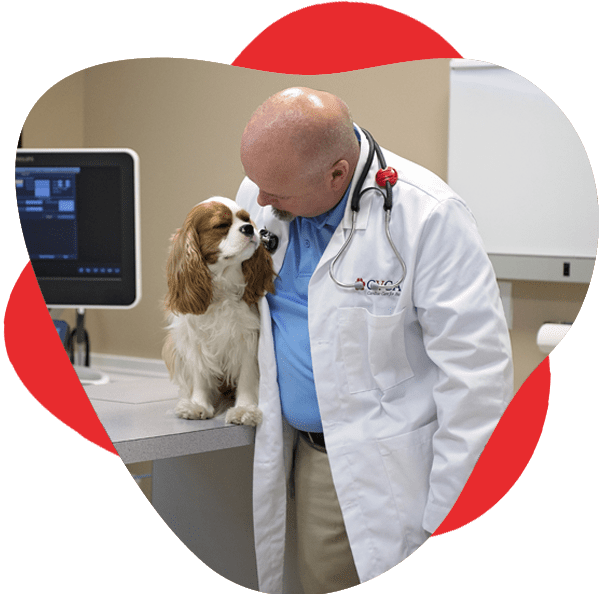The Function of Ultrasound and CT Check in Modern Veterinary Practices: Insights From Experienced Professionals
In modern-day veterinary practices, ultrasound and CT scans considerably improve diagnostic capacities. These imaging methods provide essential understandings right into animal wellness, leading treatment decisions. Experienced experts acknowledge the special benefits of each modality. Ultrasound supplies real-time assessments, while CT checks deliver intricate anatomical details. Comprehending their applications and duties increases important questions about their influence on client end results and the future of vet diagnostics. What insights can be gotten from their combined usage?
Comprehending Ultrasound in Vet Medicine
Ultrasound is a necessary analysis device in veterinary medication, supplying a non-invasive method to envision internal structures. This imaging method utilizes high-frequency acoustic waves to develop real-time photos of body organs and tissues, permitting vets to examine conditions without medical treatment. Usual applications consist of evaluating the heart, liver, kidneys, and reproductive organs, in addition to checking pregnancies.The procedure is relatively quick and can be done in numerous setups, making it an easily accessible choice for vets. Unlike radiography, ultrasound provides in-depth info regarding soft tissues and blood circulation, which is essential for exact diagnoses.Veterinary specialists rely upon ultrasound to find problems such as lumps, cysts, and liquid build-up. Its capacity to lead biopsies and other procedures better improves its utility in clinical technique. By providing a risk-free and efficient means to analyze inner makeup, ultrasound has actually come to be a keystone of modern vet diagnostics.
The Advantages of CT Checks for Animal Diagnostics
CT checks offer significant benefits in vet diagnostics by providing improved accuracy in recognizing interior conditions (Ultrasound For Dogs). As a non-invasive imaging technique, they guarantee the security and comfort of pets throughout assessments. On top of that, CT checks promote a complete analysis of internal structures, enabling more reliable therapy preparation
Enhanced Analysis Accuracy
Improvements in imaging technology have significantly boosted analysis precision in vet medication, particularly via making use of CT scans. These scans offer comprehensive cross-sectional pictures of an animal's inner structures, enabling vets to identify irregularities with precision. The high resolution and three-dimensional capacities of CT imaging facilitate the discovery of problems such as lumps, fractures, and inner bleeding that may be missed out on with conventional imaging techniques. Additionally, CT scans can aid in pre-surgical planning by providing a complete view of physiological connections. This degree of detail not only boosts the accuracy of medical diagnoses but also aids in tailoring reliable treatment plans. Consequently, the combination of CT technology into vet practices is transforming the landscape of animal healthcare, boosting outcomes for people.
Non-Invasive Imaging Technique
The introduction of non-invasive imaging methods has transformed animal diagnostics, with CT checks becoming a prominent device in vet methods. These scans supply high-resolution, cross-sectional pictures of a pet's interior structures, permitting vets to assess complex problems without the requirement for invasive treatments. The advantages of CT scans include their capability to find growths, fractures, and inner blood loss with impressive accuracy. Additionally, they help with the examination of soft cells and organs, enhancing diagnostic abilities. The speed of CT scanning makes it possible for fast decision-making, which is important in emergency situation circumstances. By decreasing stress and anxiety and pain for the pet, CT scans add to a more humane technique to diagnostics, eventually enhancing treatment results and advancing vet care.
Comprehensive Internal Evaluation
A thorough interior assessment is essential for accurate diagnosis and reliable treatment in vet medicine. CT checks offer significant advantages hereof, providing detailed cross-sectional images of a pet's interior structures. This sophisticated imaging method boosts visualization of intricate anatomical areas, making it possible for veterinarians to recognize abnormalities such as growths, fractures, and inner blood loss with better accuracy. On top of that, CT checks facilitate the evaluation of conditions that may be challenging to identify through conventional techniques. The speed and precision of CT imaging additionally contribute to timely treatments, improving person results. As vet techniques significantly integrate CT innovation, the benefits of extensive internal evaluations come to be noticeable, reinforcing the value of this tool in contemporary veterinary diagnostics.
Contrasting Ultrasound and CT Imaging Techniques
While both ultrasound and CT imaging offer necessary roles in vet diagnostics, each strategy offers distinctive advantages and limitations that can influence clinical decision-making. Ultrasound is specifically valued for its real-time imaging capabilities, permitting vets to observe vibrant physical procedures. This method is non-invasive, portable, and does not include ionizing radiation, making it a safer choice for both clinicians and pets. Ultrasound may have limitations in resource visualizing particular physiological frameworks or deep tissues.Conversely, CT imaging offers in-depth cross-sectional sights of the body, permitting for specific localization of problems. It succeeds in examining complex body organs and frameworks, particularly in the thorax and abdomen. CT scans need sedation or anesthesia in lots of cases and include exposure to ionizing radiation. Ultimately, the choice between ultrasound and CT depends on the particular medical circumstance, the area of passion, and the necessity of the analysis requirements.
Case Studies: Successful Diagnoses Through Imaging
Study illustrate the significant renovations in analysis precision attained with innovative imaging innovations like ultrasound and CT scans in vet techniques. These improvements not just boost the discovery of numerous problems yet also help with reliable and prompt treatment strategies. Analyzing particular cases can highlight the transformative influence of these imaging methods on veterinary medicine.
Diagnostic Accuracy Improvements

Imaging Innovation Advancements
As vet imaging modern technology remains to develop, its influence on diagnostic capabilities comes to be significantly evident. Current study highlight the successful application of innovative ultrasound and CT scan techniques in identifying intricate conditions. A vet facility used high-resolution CT scans to identify an uncommon form of lung cancer in a canine, which standard imaging had actually missed. An ultrasound exam exposed an abdominal mass in a pet cat, triggering prompt surgical intervention and a favorable result. These innovations not only enhance diagnostic accuracy yet likewise make it possible for veterinarians to develop targeted treatment strategies. By leveraging advanced imaging innovations, veterinary specialists are considerably enhancing person care, causing much more reliable management of different health problems in pets.
The Function of Imaging in Emergency Veterinary Treatment
Imaging plays an important role in emergency situation veterinary treatment, supplying veterinarians with crucial details needed to make quick, informed choices. In urgent scenarios, methods like ultrasound and CT scans make it possible for experts to swiftly analyze a pet dog's inner structures, identifying essential problems such as internal blood loss, fractures, or body organ irregularities. These imaging methods permit real-time evaluations, promoting prompt interventions that can be life-saving. Ultrasound is indispensable for examining soft cells injuries and problems like liquid build-up, while CT checks offer detailed photos of complicated anatomical frameworks, crucial for detecting trauma situations. The rate and precision of these imaging strategies boost the vet's capacity to devise reliable treatment plans, making certain the most effective feasible outcomes for their patients. The integration of advanced imaging technologies right into emergency situation veterinary techniques is not just valuable but significantly necessary, as it boosts diagnostic abilities and improves overall animal treatment throughout critical moments.

Training and Expertise in Vet Imaging
Although sophisticated imaging methods such as ultrasound and CT scans are important for reliable veterinary treatment, the successful execution of these innovations greatly relies on the training and proficiency of veterinary specialists. Skillful use imaging tools calls for extensive understanding of makeup, pathology, and the principles underlying each modality. Vet experts have to undertake specialized training to properly interpret imaging results, which is vital for identifying conditions and preparing treatment.Certifications and continuing education in vet imaging boost the abilities of practitioners, enabling them to stay updated with technological developments. Collaboration between veterinarians and radiologists frequently results in improved diagnostic accuracy, as professionals can supply understandings right into intricate instances. In enhancement, functional experience in managing imaging devices promotes confidence in its application. Ultimately, the quality of vet imaging solutions is straight correlated to the level of training and proficiency had by the specialists look at this site making use of these essential diagnostic devices.
Future Patterns in Diagnostic Imaging for Animals
With the quick innovations in technology, veterinary diagnostic imaging is poised for significant advancement in the coming years. Emerging trends indicate a shift towards even more obtainable and mobile imaging techniques, such as handheld ultrasound tools, which could boost area diagnostics. Additionally, the integration of artificial knowledge is expected to change photo analysis, enabling quicker and much more accurate interpretations of results.Moreover, improvements in 3D imaging techniques and calculated tomography will give veterinarians with even more comprehensive sights of pet anatomy, bring about improved treatment plans. Virtual reality modern technology might also contribute in medical planning and education and learning, giving vets an unique point of view on complex cases.As telemedicine proceeds to expand, remote examinations facilitated by analysis imaging will end up being much more typical, permitting specialists to help basic specialists in real-time. In general, these fads are readied to improve the performance and effectiveness of vet treatment, inevitably enhancing animal results.
Regularly Asked Questions
How Much Do Ultrasound and CT Checks Price in Vet Facilities?
The costs of ultrasound and CT scans in veterinary centers normally vary from $300 to $1,500, relying on aspects such as location, facility kind, and particular procedures needed for the pet's medical diagnosis and treatment.

Exist Any Type Of Dangers Connected With Ultrasound and CT Checks for Pet Dogs?
Ultrasound and CT scans typically pose marginal risks to pet dogs. Nonetheless, possible concerns include sedation responses and exposure to anesthetics. CT Scans For Dogs. Veterinarians very carefully assess each situation to mitigate any type of risks related to these diagnostic procedures
The Length Of Time Do Ultrasound and CT Treatments Typically Take?
Ultrasound procedures typically take about 30 mins to an hour, depending on the intricacy. CT scans, being even more comprehensive, normally require thirty minutes to 90 mins, consisting of preparation and healing time for the pet dog.
Can All Veterinarians Perform Ultrasounds and CT Scans?
Not all veterinarians can carry out ultrasounds and CT scans. Specialized training and accreditation are often called for to guarantee proficiency in these advanced imaging techniques, which may restrict their schedule to veterinarians with extra qualifications and sources.
What Sorts Of Pets Benefit Most From These Imaging Techniques?
Specific pet species, especially felines and dogs, advantage substantially from ultrasound and CT scans. These imaging strategies enhance diagnostic precision for problems like tumors, interior injuries, and organ problems, causing enhanced therapy results and client care. The high resolution and three-dimensional abilities of CT imaging promote the discovery of conditions such as tumors, fractures, and internal bleeding that might be missed with standard imaging techniques. Situation research studies highlight the substantial renovations in analysis precision attained with sophisticated imaging modern technologies like ultrasound and CT scans in vet practices. Improving analysis accuracy in veterinary techniques has been considerably assisted by innovations in imaging modern technologies such as ultrasound and CT scans. Sophisticated imaging methods such as ultrasound and CT scans are vital for efficient veterinary care, the effective execution of these innovations heavily depends on the training and competence of veterinary professionals. Veterinary experts need to undergo specialized training to properly analyze imaging results, which is important for diagnosing conditions and planning treatment.Certifications and proceeding education in veterinary imaging boost the skills of specialists, enabling them to stay upgraded with technological developments.